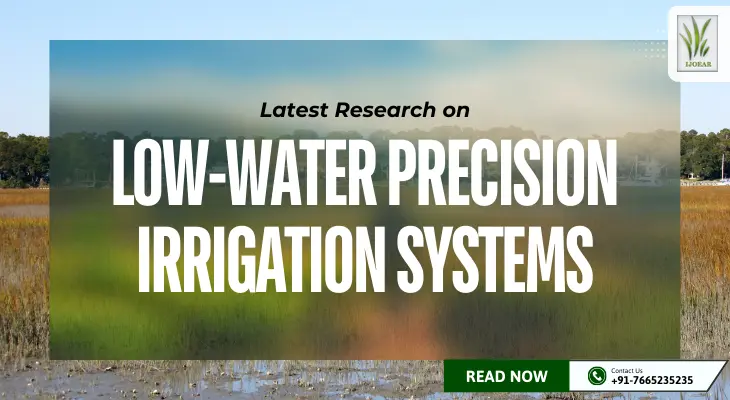
Water scarcity is becoming one of the biggest challenges for agriculture in the 21st century. According to global estimates, agriculture accounts for around 70% of all freshwater withdrawals, making efficient water use crucial for food security. With climate change intensifying droughts and depleting groundwater reserves, low-water precision irrigation systems are emerging as a sustainable solution. These systems combine advanced technology, data analytics, and crop science to deliver the exact amount of water a plant needs—no more, no less.
Recent research has shifted the focus from traditional irrigation methods, such as flood or sprinkler systems, to high-efficiency techniques like drip irrigation, subsurface delivery, and sensor-controlled systems. The goal is to increase yield while drastically reducing water wastage.
Low-water precision irrigation systems use real-time data from soil moisture sensors, weather forecasts, and crop growth models to determine optimal watering schedules. This technology ensures that water is applied directly to the root zone in precise amounts, preventing evaporation losses and overwatering.
Core components often include:
Recent scientific developments have made these systems even more efficient and accessible for farmers worldwide:
While research shows strong potential, adoption barriers remain:
Ongoing research is focused on making these systems more affordable and adaptable. Future trends include:
Low-water precision irrigation systems are no longer just an innovation—they are becoming a necessity for global food security. By combining modern technology with sustainable practices, these systems can redefine the way we grow food, particularly in water-scarce regions. Continued research and government support will be key to making this technology available to farmers at all scales, ensuring a future where agriculture thrives while conserving our most precious resource—water.
A low-water precision irrigation system is an advanced agricultural technique that delivers the exact amount of water needed directly to the plant root zone, minimizing waste. It uses sensors, automation, and data analysis to optimize water usage while maintaining or improving crop yields.
By monitoring soil moisture, weather conditions, and crop water requirements, precision irrigation systems provide targeted watering. This prevents over-irrigation, reduces evaporation losses, and ensures that plants get water only when they need it, saving up to 30–60% more water compared to traditional methods.
Current systems integrate soil moisture sensors, weather stations, satellite imaging, drip irrigation lines, and automated valves. AI-based analytics and IoT devices further improve accuracy by predicting water needs in real time.
While it works best for high-value crops like fruits, vegetables, and nuts, research is expanding its application to cereals, pulses, and even forage crops. The adaptability depends on soil type, crop water needs, and the farmer’s infrastructure.
Costs vary depending on the technology used. However, innovations in low-cost sensors and solar-powered pumps are making it more accessible. Governments and NGOs in countries like India, Kenya, and Brazil are offering subsidies to promote adoption.
Yes. In rainfed regions, these systems can be combined with rainwater harvesting and smart scheduling to supplement natural rainfall, ensuring consistent crop growth during dry spells.
It reduces water wastage, minimizes fertilizer runoff, lowers energy use for pumping, and helps maintain groundwater levels. This makes it a sustainable solution for water-scarce regions and a key part of precision agriculture.
Recent studies are exploring AI-based irrigation scheduling, crop-specific algorithms, biodegradable drip lines, and integration with renewable energy. Trials in Israel, California, and parts of India show significant water savings with equal or higher yields.
In most cases, noticeable improvements in water savings and crop health can be observed within one or two growing seasons, depending on crop type and system efficiency.
The future points towards fully autonomous irrigation systems powered by AI, capable of self-adjusting in real time based on plant stress levels detected through thermal imaging and drone surveillance. This aligns with the broader trends of the future of sustainable farming.
 NAAS Rating: 4.23
NAAS Rating: 4.23  October 2025 Issue
October 2025 Issue  Impact Factor: 6.69
Impact Factor: 6.69  Submit Article
Submit Article 
|
Citation Indices
|
All
|
Since 2020
|
|
Citation
|
6164
|
5117
|
|
h-index
|
31
|
29
|
|
i10-index
|
201
|
165
|
|
Acceptance Rate (By Year)
|
|
|
Year
|
Percentage
|
|
2024
|
11.09%
|
|
2023
|
15.23%
|
|
2022
|
12.81%
|
|
2021
|
10.45%
|
|
2020
|
9.6%
|
|
2019
|
14.3%
|
|
2018
|
17.65%
|
|
2017
|
16.9%
|
|
2016
|
22.9%
|
|
2015
|
26.1%
|